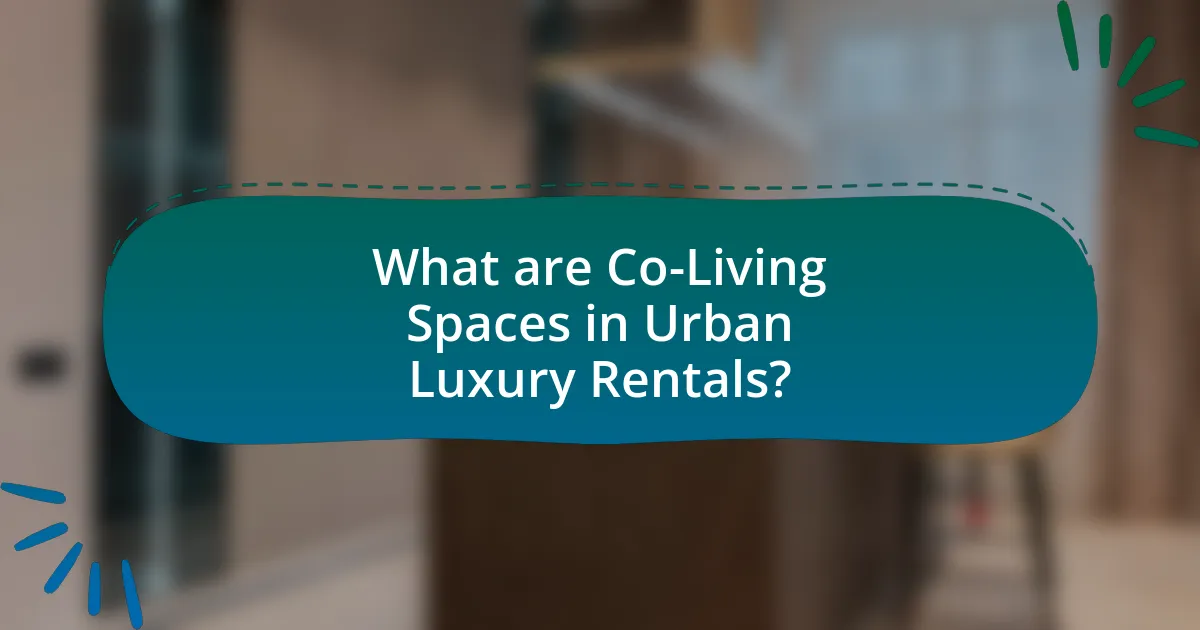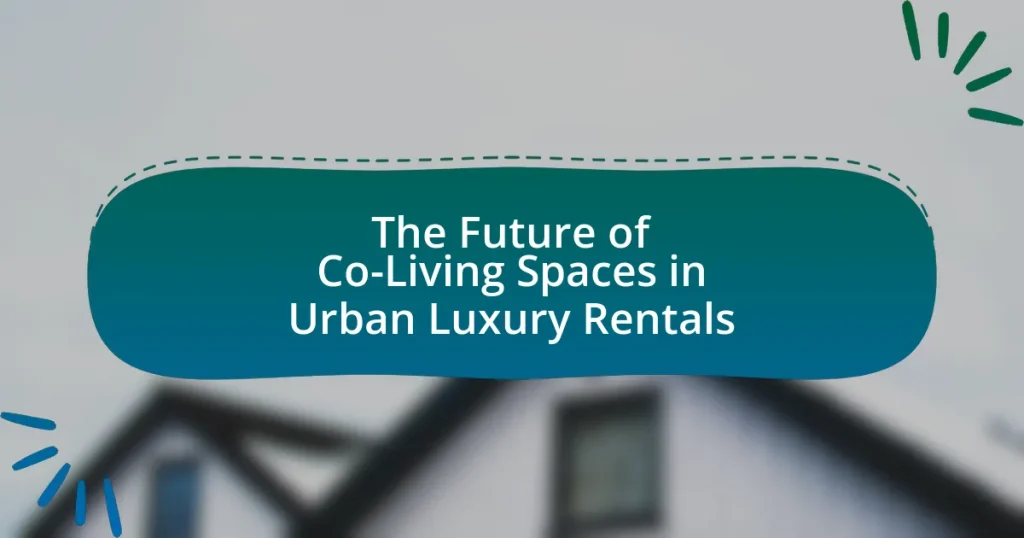Co-living spaces in urban luxury rentals represent a modern housing solution that combines shared living environments with high-end amenities, catering primarily to young professionals and urban dwellers. This article explores the distinct characteristics of co-living spaces compared to traditional rentals, highlighting their communal living arrangements, flexible lease terms, and inclusive pricing. It examines the growing popularity of co-living driven by urbanization, remote work trends, and changing lifestyle preferences, while also addressing challenges such as market saturation and regulatory impacts. Additionally, the article discusses innovations in co-living design, the role of technology, and sustainable practices that enhance the living experience, ultimately providing insights into the future of co-living spaces as a viable and attractive option in urban luxury markets.

What are Co-Living Spaces in Urban Luxury Rentals?
Co-living spaces in urban luxury rentals are shared living environments that offer high-end amenities and communal areas designed for collaboration and social interaction among residents. These spaces typically feature private bedrooms with shared kitchens, lounges, and workspaces, catering to young professionals and urban dwellers seeking a community-oriented lifestyle. The rise of co-living is supported by the increasing demand for flexible living arrangements, with a reported 30% growth in co-living developments in major cities over the past five years, indicating a shift in housing preferences towards more communal and affordable luxury options.
How do Co-Living Spaces differ from traditional rentals?
Co-living spaces differ from traditional rentals primarily in their communal living arrangements and shared amenities. In co-living spaces, residents typically share common areas such as kitchens, lounges, and workspaces, fostering a sense of community and collaboration, while traditional rentals usually offer private living spaces with limited shared facilities. Additionally, co-living arrangements often include flexible lease terms and all-inclusive pricing, which covers utilities and services, contrasting with traditional rentals that may require longer commitments and separate utility payments. This model caters to the growing demand for affordable, community-oriented living, particularly among young professionals and students in urban areas.
What amenities are typically included in Co-Living Spaces?
Co-living spaces typically include amenities such as fully furnished private and shared living areas, high-speed internet, communal kitchens, laundry facilities, and recreational spaces. These amenities are designed to foster community interaction and provide convenience for residents. Additionally, many co-living spaces offer utilities like water, electricity, and cleaning services included in the rent, enhancing the overall living experience. The inclusion of these amenities is supported by industry trends indicating that co-living arrangements are increasingly popular among young professionals and students seeking affordable, community-oriented housing solutions.
How does the design of Co-Living Spaces enhance luxury living?
The design of co-living spaces enhances luxury living by integrating high-end amenities, communal areas, and personalized services that foster a sense of community while providing individual comfort. These spaces often feature modern architecture, upscale furnishings, and smart home technology, which cater to the preferences of affluent residents. For instance, co-living developments frequently include amenities such as fitness centers, rooftop gardens, and co-working spaces, which promote a lifestyle of convenience and social interaction. Research indicates that 70% of millennials prefer living in community-oriented environments, highlighting the demand for such designs in luxury urban rentals.
Why are Co-Living Spaces gaining popularity in urban areas?
Co-living spaces are gaining popularity in urban areas primarily due to the increasing demand for affordable housing and community-oriented living. Urban centers are experiencing a surge in population, leading to high rental prices and a scarcity of traditional housing options. Co-living arrangements offer a cost-effective solution by providing shared living spaces that reduce individual housing expenses while fostering a sense of community among residents. According to a report by JLL, the co-living market is projected to grow significantly, with an estimated value of $13.9 billion by 2025, reflecting the rising interest in flexible living arrangements that cater to millennials and young professionals seeking both affordability and social interaction.
What demographic trends are driving the demand for Co-Living Spaces?
The demand for co-living spaces is primarily driven by urbanization, the rise of remote work, and changing lifestyle preferences among millennials and Gen Z. Urbanization has led to increased population density in cities, creating a need for affordable housing solutions. The rise of remote work has made flexible living arrangements more appealing, allowing individuals to prioritize community and shared resources. Additionally, millennials and Gen Z value experiences and social connections over traditional homeownership, further fueling interest in co-living environments. According to a report by JLL, co-living spaces are expected to grow by 20% annually, reflecting these demographic shifts.
How do lifestyle changes influence the appeal of Co-Living Spaces?
Lifestyle changes significantly enhance the appeal of co-living spaces by aligning with the growing demand for community-oriented living and flexibility. As urban populations increase, individuals prioritize social interaction, affordability, and convenience, making co-living an attractive option. According to a report by JLL, 70% of millennials prefer living in shared spaces due to the sense of community and shared amenities, which cater to their lifestyle preferences. Additionally, the rise of remote work has led to a demand for flexible living arrangements, further increasing the attractiveness of co-living spaces that offer short-term leases and communal workspaces. These lifestyle shifts demonstrate that co-living spaces are not just housing solutions but also lifestyle choices that resonate with modern urban dwellers.
What challenges do Co-Living Spaces face in urban luxury markets?
Co-living spaces in urban luxury markets face significant challenges, primarily related to high operational costs and market saturation. The high cost of real estate in urban luxury areas increases the financial burden on co-living operators, making it difficult to maintain competitive pricing while ensuring quality amenities. Additionally, the growing popularity of co-living has led to market saturation, resulting in intense competition among providers. According to a report by JLL, the demand for co-living spaces has surged, but the oversupply in certain urban areas has led to a decline in occupancy rates, further complicating profitability for operators.
How do regulations impact the development of Co-Living Spaces?
Regulations significantly impact the development of co-living spaces by dictating zoning laws, building codes, and occupancy limits. These regulations can either facilitate or hinder the establishment of co-living environments, as they determine the legal framework within which developers must operate. For instance, strict zoning laws may limit the areas where co-living spaces can be constructed, while building codes can impose additional costs and design constraints that affect project feasibility. In cities like San Francisco, regulations have been known to slow down the approval process for new housing developments, including co-living spaces, thereby exacerbating housing shortages. Furthermore, occupancy limits can restrict the number of residents in a co-living space, impacting the financial viability of such projects. Overall, the regulatory landscape plays a crucial role in shaping the growth and sustainability of co-living spaces in urban luxury rentals.
What are the common misconceptions about Co-Living Spaces?
Common misconceptions about co-living spaces include the belief that they are only for young people, that they lack privacy, and that they are inherently low-quality. Many assume co-living is exclusively targeted at millennials or students, but a diverse range of age groups and professionals are increasingly drawn to these communal living arrangements. Additionally, while co-living spaces often emphasize shared amenities, they typically offer private rooms and personal space, countering the notion that privacy is compromised. Furthermore, the quality of co-living spaces can vary, but many are designed with modern aesthetics and high-end features, challenging the stereotype of being subpar housing options.

How is the Future of Co-Living Spaces Shaping Up?
The future of co-living spaces is increasingly focused on flexibility, community engagement, and enhanced amenities. As urban populations grow, demand for affordable yet luxurious living arrangements rises, prompting developers to create co-living environments that cater to diverse lifestyles. According to a report by JLL, the global co-living market is projected to reach $13.9 billion by 2025, indicating significant investment and interest in this sector. This growth is driven by millennials and Gen Z, who prioritize experiences and community over traditional homeownership, leading to innovative designs that foster social interaction and shared resources.
What innovations are emerging in Co-Living Spaces?
Innovations in co-living spaces include the integration of smart technology, flexible lease options, and enhanced community engagement features. Smart technology, such as IoT devices for energy management and security, allows residents to control their living environment efficiently. Flexible lease options cater to the growing demand for short-term living arrangements, appealing to digital nomads and transient professionals. Enhanced community engagement features, like organized events and shared workspaces, foster a sense of belonging and collaboration among residents. These innovations reflect the evolving needs of urban dwellers seeking convenience, connectivity, and community in luxury rental environments.
How is technology enhancing the Co-Living experience?
Technology is enhancing the co-living experience by facilitating seamless communication, optimizing resource management, and improving community engagement. Smart home devices, such as IoT-enabled appliances and security systems, allow residents to control their living environment remotely, enhancing convenience and safety. Additionally, digital platforms enable residents to connect with each other, share resources, and organize community events, fostering a sense of belonging. According to a report by JLL, 70% of co-living residents value technology that enhances their living experience, indicating its significant role in shaping modern co-living spaces.
What sustainable practices are being integrated into Co-Living Spaces?
Sustainable practices integrated into co-living spaces include energy-efficient designs, waste reduction initiatives, and the use of sustainable materials. Energy-efficient designs often incorporate solar panels and smart home technology to minimize energy consumption, which can reduce utility costs by up to 30% according to the U.S. Department of Energy. Waste reduction initiatives, such as composting and recycling programs, help divert significant amounts of waste from landfills, with some co-living spaces achieving over 50% waste diversion rates. Additionally, the use of sustainable materials, such as reclaimed wood and low-VOC paints, contributes to healthier living environments and reduces the carbon footprint of construction. These practices not only enhance the sustainability of co-living spaces but also appeal to environmentally conscious residents.
How are market trends influencing the future of Co-Living Spaces?
Market trends are significantly shaping the future of co-living spaces by driving demand for flexible, affordable housing solutions in urban areas. The rise of remote work has increased the need for adaptable living arrangements, as individuals seek community-oriented environments that offer both privacy and shared amenities. According to a report by JLL, the co-living market is projected to grow at a compound annual growth rate of 25% from 2021 to 2025, indicating a strong shift towards this housing model. Additionally, urbanization trends show that more people are moving to cities, further fueling the demand for co-living spaces that cater to diverse lifestyles and budgets.
What role does remote work play in the evolution of Co-Living Spaces?
Remote work significantly influences the evolution of co-living spaces by increasing demand for flexible living arrangements that accommodate professional needs. As more individuals work remotely, they seek environments that provide both personal and professional amenities, leading to the design of co-living spaces that include dedicated work areas, high-speed internet, and communal spaces for collaboration. According to a report by JLL, 70% of employees prefer flexible work arrangements, which drives the need for co-living spaces that cater to this lifestyle. This shift not only enhances the appeal of co-living as a viable housing option but also encourages developers to innovate in creating spaces that blend work and leisure effectively.
How are economic factors affecting the growth of Co-Living Spaces?
Economic factors significantly influence the growth of co-living spaces by driving demand for affordable housing solutions in urban areas. Rising housing costs and stagnant wages have led to an increased interest in co-living arrangements, as they offer a more economical alternative to traditional rentals. According to a report by JLL, the global co-living market is projected to reach $13.9 billion by 2025, reflecting a growing acceptance of shared living environments among millennials and Gen Z, who prioritize affordability and community. Additionally, economic uncertainties, such as those caused by the COVID-19 pandemic, have prompted individuals to seek flexible living arrangements, further accelerating the trend towards co-living spaces.

What are the Key Considerations for Investors in Co-Living Spaces?
Key considerations for investors in co-living spaces include understanding market demand, evaluating location, assessing regulatory environments, and analyzing financial viability. Market demand is crucial, as co-living appeals to millennials and young professionals seeking affordable housing options in urban areas. Location significantly impacts occupancy rates; properties near public transport, amenities, and employment hubs tend to attract more tenants. Regulatory environments can affect operational flexibility and profitability, so investors must be aware of local zoning laws and housing regulations. Financial viability involves calculating potential returns on investment, considering operational costs, and understanding pricing strategies to remain competitive while ensuring profitability.
What financial models are most effective for Co-Living Spaces?
The most effective financial models for co-living spaces include revenue-sharing agreements, subscription-based pricing, and flexible leasing options. Revenue-sharing agreements allow property owners to partner with operators, sharing profits based on occupancy rates, which aligns incentives and reduces risk. Subscription-based pricing offers residents a fixed monthly fee that covers rent and utilities, providing predictable income for operators and appealing to tenants seeking financial stability. Flexible leasing options, such as short-term leases or month-to-month agreements, attract a diverse tenant base, accommodating varying needs and increasing occupancy rates. These models have been validated by industry trends showing that co-living spaces with adaptable financial structures experience higher occupancy and tenant satisfaction, as evidenced by a 2021 report from JLL indicating that flexible living arrangements are increasingly preferred by urban dwellers.
How can investors assess the profitability of Co-Living Spaces?
Investors can assess the profitability of co-living spaces by analyzing key financial metrics such as occupancy rates, rental yields, and operating expenses. High occupancy rates, typically above 85%, indicate strong demand, while rental yields of 8-12% are considered favorable in urban markets. Additionally, evaluating operating expenses, which should ideally remain below 30% of gross revenue, helps in understanding the cost efficiency of the investment. Market trends, such as the increasing preference for flexible living arrangements among millennials and young professionals, further support the potential profitability of co-living spaces.
What risks should investors be aware of in the Co-Living market?
Investors in the Co-Living market should be aware of several key risks, including regulatory changes, market saturation, and tenant turnover. Regulatory changes can impact operational costs and compliance requirements, as local governments may impose new zoning laws or rental regulations that affect profitability. Market saturation poses a risk as the increasing popularity of co-living spaces may lead to an oversupply in certain urban areas, driving down rental prices and occupancy rates. Additionally, high tenant turnover can result in increased operational costs and reduced revenue, as frequent leasing and marketing efforts are necessary to fill vacancies. These factors collectively create a volatile investment environment in the co-living sector.
What best practices should be followed when developing Co-Living Spaces?
When developing co-living spaces, best practices include prioritizing community engagement, designing flexible living arrangements, and ensuring high-quality amenities. Community engagement fosters a sense of belonging among residents, which is essential for co-living success; studies show that social interaction can enhance resident satisfaction and retention. Flexible living arrangements, such as adaptable room layouts and shared spaces, cater to diverse lifestyles and preferences, accommodating both short-term and long-term residents. High-quality amenities, including reliable internet, communal kitchens, and recreational areas, are critical as they enhance the living experience and attract potential tenants. According to a report by JLL, properties with superior amenities can command higher rental prices and achieve lower vacancy rates, validating the importance of these practices in co-living space development.
How can developers create a community-focused environment in Co-Living Spaces?
Developers can create a community-focused environment in co-living spaces by designing shared amenities that encourage interaction, such as communal kitchens, lounges, and event spaces. These features facilitate social engagement among residents, fostering a sense of belonging. Research indicates that co-living spaces with well-planned communal areas report higher resident satisfaction and lower turnover rates, as seen in studies conducted by the Urban Land Institute, which highlight the importance of community in enhancing the living experience. Additionally, organizing regular community events and activities can further strengthen relationships among residents, creating a vibrant and cohesive community atmosphere.
What strategies can enhance tenant retention in Co-Living Spaces?
To enhance tenant retention in co-living spaces, property managers should implement community-building activities, offer flexible lease terms, and maintain high-quality amenities. Community-building activities, such as social events and workshops, foster a sense of belonging among tenants, which is crucial for retention; studies show that engaged residents are 30% more likely to renew their leases. Flexible lease terms cater to diverse tenant needs, allowing for shorter commitments that can attract a wider audience. Additionally, maintaining high-quality amenities, such as modern kitchens and recreational areas, directly impacts tenant satisfaction, with 75% of tenants citing amenities as a key factor in their decision to stay.
What practical tips can help individuals navigate Co-Living Spaces?
To effectively navigate co-living spaces, individuals should prioritize clear communication with housemates and management. Establishing open lines of dialogue fosters a collaborative environment, which is essential in shared living situations. Additionally, individuals should familiarize themselves with the house rules and communal responsibilities to ensure a harmonious living experience. Research indicates that co-living arrangements often emphasize community engagement, making participation in communal activities beneficial for building relationships and enhancing the living experience. Furthermore, utilizing shared resources efficiently, such as communal kitchens and lounges, can maximize the benefits of co-living while minimizing personal expenses.


